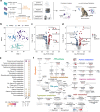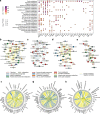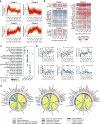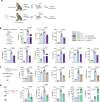Integrated cytokine and metabolite analysis reveals immunometabolic reprogramming in COVID-19 patients with therapeutic implications
- PMID: 33712622
- PMCID: PMC7955129
- DOI: 10.1038/s41467-021-21907-9
Integrated cytokine and metabolite analysis reveals immunometabolic reprogramming in COVID-19 patients with therapeutic implications
Abstract
Cytokine release syndrome (CRS) is a major cause of the multi-organ injury and fatal outcome induced by SARS-CoV-2 infection in severe COVID-19 patients. Metabolism can modulate the immune responses against infectious diseases, yet our understanding remains limited on how host metabolism correlates with inflammatory responses and affects cytokine release in COVID-19 patients. Here we perform both metabolomics and cytokine/chemokine profiling on serum samples from healthy controls, mild and severe COVID-19 patients, and delineate their global metabolic and immune response landscape. Correlation analyses show tight associations between metabolites and proinflammatory cytokines/chemokines, such as IL-6, M-CSF, IL-1α, IL-1β, and imply a potential regulatory crosstalk between arginine, tryptophan, purine metabolism and hyperinflammation. Importantly, we also demonstrate that targeting metabolism markedly modulates the proinflammatory cytokines release by peripheral blood mononuclear cells isolated from SARS-CoV-2-infected rhesus macaques ex vivo, hinting that exploiting metabolic alterations may be a potential strategy for treating fatal CRS in COVID-19.
Conflict of interest statement
The authors declare no competing interests.
Figures




Similar articles
-
Diagnosis of SARS-CoV-2 infection in the setting of the cytokine release syndrome.Expert Rev Mol Diagn. 2020 Nov;20(11):1087-1097. doi: 10.1080/14737159.2020.1830760. Epub 2020 Oct 12. Expert Rev Mol Diagn. 2020. PMID: 32990479
-
Are all cytokine storms the same?Cancer Immunol Immunother. 2021 Apr;70(4):887-892. doi: 10.1007/s00262-020-02822-2. Epub 2021 Jan 8. Cancer Immunol Immunother. 2021. PMID: 33416946 Free PMC article.
-
Coronavirus-19 (SARS-CoV-2) induces acute severe lung inflammation via IL-1 causing cytokine storm in COVID-19: a promising inhibitory strategy.J Biol Regul Homeost Agents. 2020 Nov-Dec;34(6):1971-1975. doi: 10.23812/20-1-E. J Biol Regul Homeost Agents. 2020. PMID: 33016027
-
COVID-19 and hepatic involvement: The liver as a main actor of the pandemic novel.Scand J Immunol. 2021 Mar;93(3):e12977. doi: 10.1111/sji.12977. Epub 2020 Sep 26. Scand J Immunol. 2021. PMID: 32931622 Review.
-
SARS-CoV-2 infection: The role of cytokines in COVID-19 disease.Cytokine Growth Factor Rev. 2020 Aug;54:62-75. doi: 10.1016/j.cytogfr.2020.06.001. Epub 2020 Jun 2. Cytokine Growth Factor Rev. 2020. PMID: 32513566 Free PMC article. Review.
Cited by
-
Emerging Role of Nicotinamide Riboside in Health and Diseases.Nutrients. 2022 Sep 20;14(19):3889. doi: 10.3390/nu14193889. Nutrients. 2022. PMID: 36235542 Free PMC article. Review.
-
Metabolic Reprogramming in COVID-19.Int J Mol Sci. 2021 Oct 25;22(21):11475. doi: 10.3390/ijms222111475. Int J Mol Sci. 2021. PMID: 34768906 Free PMC article. Review.
-
Metabolomics-directed nanotechnology in viral diseases management: COVID-19 a case study.Pharmacol Rep. 2023 Oct;75(5):1045-1065. doi: 10.1007/s43440-023-00517-w. Epub 2023 Aug 16. Pharmacol Rep. 2023. PMID: 37587394 Free PMC article. Review.
-
Deciphering the Relationship between SARS-CoV-2 and Cancer.Int J Mol Sci. 2023 Apr 25;24(9):7803. doi: 10.3390/ijms24097803. Int J Mol Sci. 2023. PMID: 37175509 Free PMC article. Review.
-
Unraveling metabolic signatures in SARS-CoV-2 variant infections using multiomics analysis.Front Immunol. 2024 Dec 11;15:1473895. doi: 10.3389/fimmu.2024.1473895. eCollection 2024. Front Immunol. 2024. PMID: 39759510 Free PMC article.
References
Publication types
MeSH terms
Substances
LinkOut - more resources
Full Text Sources
Other Literature Sources
Medical
Research Materials
Miscellaneous

